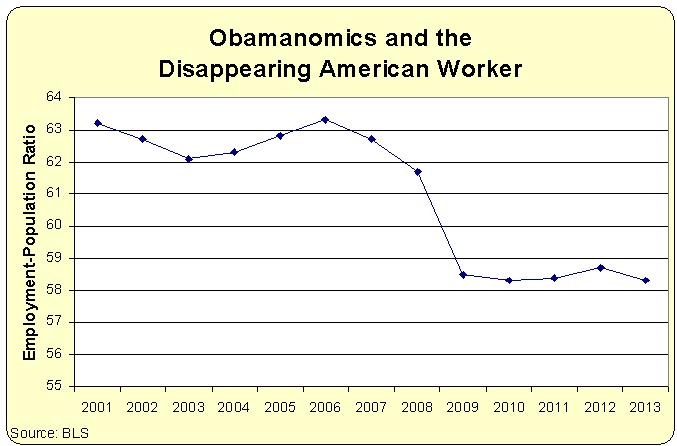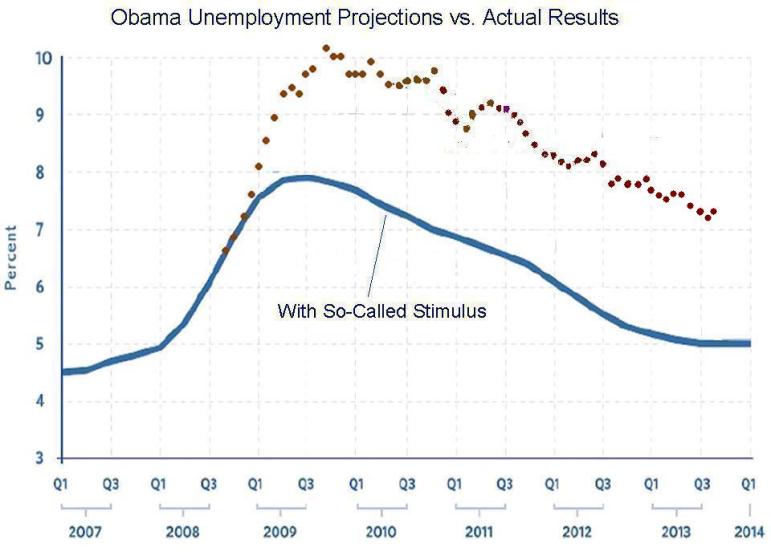OBAMANOMICS AND THE VANISHING AMERICAN WORKER: DANIEL MITCHELL
http://www.thecommentator.com/article/4342/obamanomics_and_the_vanishing_american_worker
The Department of Labor has issued its monthly employment report and the item that will attract the most attention is that the unemployment rate marginally increased to 7.3 percent.
That number is worthy of some attention, but I think it distracts attention from a far more important set of data. What we should be more worried about is the overall supply of employed workers.
I don’t want to sound like a boring economist (is there any other kind?), but our economic well being is a function of what we produce, and and what we produce is a function of the amount of labor and capital that is being productively utilized. We economists use jargon about “factors of production,” but what we’re really trying to say is that our living standards depend on good jobs and wise investment.
Which is why the most depressing bit of data from the Labor Department isn’t the unemployment rate. We should be far more worried about the employment-population ratio.
Here’s a chart based on DOL data showing the percent of the working-age population that is employed (click here to see the Labor Department’s explanation of this variable). As you can see, that key number used to be close to 63 percent. Now it’s down close to 58 percent.
To be fair, this isn’t all Obama’s fault. Not even close.
The big drop occurred at the end of the Bush years. Some of that drop was cyclical, caused by the recession. And some of it was presumably the cumulative impact of Bush’s big-government policies.
But what’s noteworthy is that the recession has been over since mid-2009 and the employment-population ratio hasn’t improved. And that’s something that we can blame in part on Obama.
It’s not just cranky libertarians who worry about this trend in the employment data.
William Galston of the Brookings Institution shares some very disturbing numbers in a Wall Street Journal column about the decline in labor force participation in the United States:
“The great American jobs machine is faltering, and it is time for Washington to pay attention. Participation in the workforce is falling, the pace of job creation is anemic, and long-term unemployment remains stubbornly high. …the United States was once viewed as the home of the “employment miracle.”
“As recently as 1989, it was a leader in labor-force participation and employment rates among the world’s most developed economies. That is no longer the case. …When we consider prime-age workers age 35 to 54—past the period of extended education that success in the 21st century economy so often requires—the comparison looks even worse: Average participation rates in the 16 comparison countries are four to six points higher than they are in the U.S. Last year, the U.S. ranked in the bottom third for women, and dead last for men. …prospects for robust growth and shared prosperity are dim unless we can devise more effective labor-market policies.”
I suspect Galston and I would only partly agree on “effective labor-market policies,” but I think a big part of the answer is smaller government and less intervention.
If we want more jobs, we need to make it more profitable for employers to create jobs. And, as this very clever cartoon parody indicates (and also as shown in this great Chuck Asay cartoon), we need to make it more attractive for people to get back in the job market.
Let’s conclude by returning to the data on the unemployment rate. I don’t think it’s particularly newsworthy that the joblessness rate crept up by a small amount. Any single month of data, after all, might be a statistical blip.
However, I can’t resist pointing out that today’s unemployment rate is still more than two percentage points higher than the White House claimed it would be if we enacted the failed stimulus.
Here’s an updated version of the chart showing the gap between what the Obama Administration promised and what’s been delivered.
Yup, good old Keynesian economics. Over-promising and under-delivering ever since the failed policies of Hoover and Roosevelt.
P.S. At least one liberal recognizes the dangers of government-subsidized dependency.
Daniel J. Mitchell is a Senior Fellow at the Cato Institute, the free-market, Washington D.C. think tank. His articles are cross-posted on his blog by agreement
Comments are closed.


